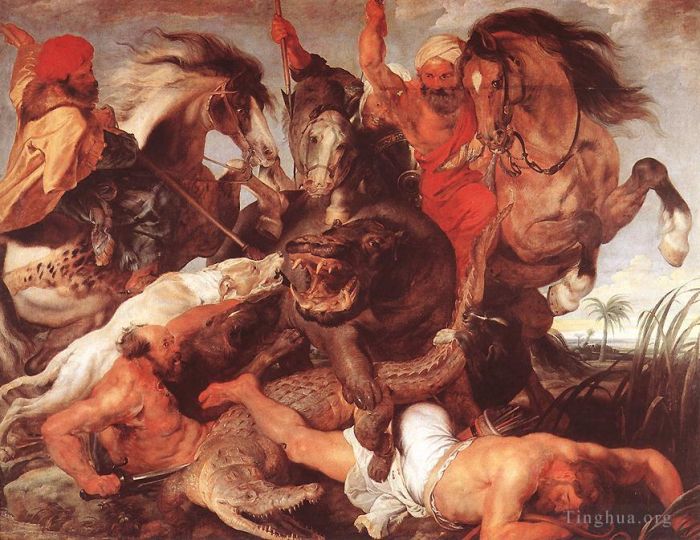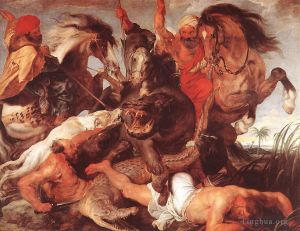Hippopotamus and Crocodile Hunt
Peter Paul Rubens
- Price: Price on Request
- Art Type: Oil Painting
- Size:
- English Comments: 0
- International Comments: 0
- Creating Date:
- Introduction and Works of Peter Paul Rubens >>
Work Overview
- The Hippopotamus and Crocodile Hunt
Peter Paul Rubens
Date: c.1615 - c.1616
Style: Baroque
Genre: genre painting
Media: oil, canvas
Dimensions: 321 x 248 cm
Location: Alte Pinakothek, Munich, Germany
The Hippopotamus and Crocodile Hunt is an oil painting on canvas by Peter Paul Rubens (Flemish, 1577–1640). It was commissioned in 1615 to decorate Schleißheim Palace, along with three other works depicting lion, wolf, and boar hunts. The cycle of paintings were looted from the palace during the Napoleonic Wars. Only the Hippopotamus and Crocodile Hunt was returned to Munich,[1] at which time it was added to the collection that is now the Alte Pinakothek.
Peter Paul Rubens created the canvas oil painting entitled The Hippopotamus and Crocodile Hunt between 1615–16. The hunt takes place on the banks of the Nile, as indicated by a palm tree in the background. As hippopotami and crocodiles were considered dangerous nuisances, their destruction was a duty performed by noblemen. The hunting party comprises three men in orientalizing costume—mounted on Arabian horses, who hunt with lance and sword—and two valets clad in roughly-hewn jerkins—one of whom has been killed by one of the beasts. The enraged hippopotamus tramples the crocodile, as both are attacked by the hunters and hounds. The accurately-rendered physical appearances of the hippopotamus and crocodile contrasts with contemporary renderings[2] and reflect the period's growing interest in empiricism and natural history. It has been suggested that Rubens may have traveled to Rome to view a temporarily-displayed dead hippopotamus preserved in brine prior to the painting of the picture.
Rubens created the genre of the large hunting scene[citation needed] and his studio produced dozens for aristocratic patrons in the 1610s and 1620s. Maximilian I, Elector of Bavaria, commissioned the Hippopotamus and Crocodile Hunt three others depicting lion, wolf, and boar hunts, in 1615 to decorate Schleißheim Palace, the summer residence of the Wittelsbach princes. Rubens and his studio produced the four large canvases in Antwerp over the years 1615–16. The Wittelsbach collection formed the nucleus of Alte Pinakothek in Munich, the present location of the Hippopotamus and Crocodile Hunt and The Lion Hunt from the same cycle. The cycle of paintings were looted from the palace during the Napoleonic Wars. Only the Hippopotamus and Crocodile Hunt was returned to Munich,[1] at which time it was added to the collection that is now the Alte Pinakothek.
The complexity of the figure grouping, representation of turbulent motion and violent action, high drama, and brilliant palette are hallmarks of Rubens' style. In the notice of January 25, 1847, Eugène Delacroix admired the crocodile as a "masterpiece of execution", remarking, however, that "its action could have been more interesting".
The Hippopotamus and Crocodile Hunt is a large painting by Peter Paul Rubens, featuring the hunt on hippopotamus and crocodile with three hunting dogs. There is also a reference to a leopard in the pelt on the horse of the upper left rider. Rubens used the dramatics of diagonals to heighten the sense of immediacy and movement and redirected attention downward into the center of action.
The Hippopotamus and Crocodile Hunt is one of the four hunting paintings, commissioned by Maximilian I, Elector of Bavaria to decorate the old Schleissheim Palace. After the seizure of this cycle during the Napoleonic Wars only The Hippopotamus and Crocodile Hunt was returned to Munich. In the notice of January 25, 1847 Eugene Delacroix admired the crocodile as a "masterpiece of execution", remarking, however, that "its action could have been more interesting".
Although not realistic, Hippopotamus and Crocodile Hunt is a statement about man's struggle with the beast as well as nature as a whole. It is a painting of opposites between smooth and scaly, dark and light, the high and low, beauty and barbaric.
This painting is an excellent example of the Baroque style because it uses vivid colors to portray a dramatic and highly emotional scene. The layout of the painting is slightly off center with most of the action happening to the left side of the painting and a calm spot to the right. The Hippopotamus and Crocodile Hunt is a great example of how artists of that time captured emotion and movement.
- Copyright Statement:
All the reproduction of any forms about this work unauthorized by Singing Palette including images, texts and so on will be deemed to be violating the Copyright Laws.
To cite this webpage, please link back here.
- >> English Comments
- >> Chinese Comments
- >> French Comments
- >> German Comments
- >>Report
- The Straw Hat (Portrait of Susanna Lunden)
- Stormy Landscape
- Decius Mus Addressing the Legions
- Entombment 1615
- Romulus and Remus
- Dance of Mythological Characters and Villagers
- Adoration of the Magi 1626
- Portrait of lady arundel with her train
- Virgin in Adoration before the Christ Child
- Boy with Bird
- The Duke of Buckingham
- The meeting of the king and marie de medici at lyons 9th november 1601625
- St augustine
- The Abduction of Ganymede
- St cecilia 1640
- Portrait of Helena Fourment
- Assumption of the Virgin
- Samson and Delilah
- Landscape with Saint George and the Dragon
- The holy family with st elizabeth 1611
- The Consequences of War
- Susanna and the elders 1610
- Christ and St. John with Angels
- Portrait of a Woman
- The Death of Seneca
- The Honeysuckle Bower (The Artist and His First Wife Isabella Brant in the Honeysuckle Bower)
- King solomon and the queen of sheba
- Duke of Lerma
- Pan and Syrinx
- Venus Cupid Bacchus and Ceres
- Saint Gregory With Saints Domitilla Maurus And Papianus
- Prometheus bound
- Adam and Eve
- The Mantuan Circle Of Friends
- Massacre of the Innocents
- The Three Crosses
- Tereus Confronted with the Head of his Son Itylus
- Madonna in Floral Wreath
- Nymphs and Satyrs
- The Fall of Phaeton
- Cimon and Pero (Roman Charity)
- The Circumcision of Christ
- Satyr and girl
- The Road to Calvary
- Christ at Simon the Pharisee
- The Meeting of Abraham and Melchizedek
- The Lion Hunt
- Daniel in the Lions Den
- Bathsheba at the fountain
- The Triumphal Car of Kallo Sketch
- Cupid making his bow
- Adoration of the Shepherds
- Mars and Rhea Silvia
- The Triumph of the Church
- Peace and abundance
- St Domitilla with St Nereus and St Achilleus
- The Last Communion of St Francis
- Descent from the Cross 1616
- Peace And War
- The Four Philosophers
- Venus in Fur Coat
- Diana returning from hunt
- Assumption of the Virgin 1626
- The Landing of Marie de Medici at Marseilles
- Mercury and Argus
- Landscape with a Rainbow 1632
- Beheading of St John the Baptist
- Christ on the Cross 1627
- Peter Paul Head and right hand of a woman
- Perseus and andromeda 1640
- Perseus and Andromeda
- Annunciation 1628
- The Resurrection of Christ
- Diana and Callisto
- The Kermesse
- Tournament in front of castle steen 1637
- Portrait of Marchesa Brigida Spinola-Doria
- The Supper At Emmaus
- Portrait Of A Man
- Rubens His Wife Helena Fourment and Their Son Frans
- Rubens In His Garden With Helena Fourment
- The Garden Of Love
- Marie de Medici Queen of France
- The Judgment of Paris 1639
- The Cardinal Infante
- Sine Cerere et Baccho friget Venus
- Battle of the Amazons
- Madonna Enthroned with Child and Saints
- Hero And Leander
- Farm at Laken
- Sine Cerere et Baccho friget Venus
- Bethrotal of St Catherine sketch
- The Triumph of Victory
- Adam and eve big
- The meeting of abraham and melchisedek 1621
- Chateau de Steen
- Peter Paul Portrait Of A Man Probably Peter Van Hecke
- Susanna and the elders
- St James the Apostle
- Christ on the Cross between the Two Thieves
- Head of a Franciscan Friar
- Return of the Prodigal Son
- Portrait of a Chambermaid Chalk
- Peter Paul Portrait Of A Woman Probably His Wife
- Portrait of Jan Gaspar Gevartius
- The Holy Family with the Basket
- The Holy Family with St Anne
- The Four Continents
- Woman with a Mirror
- Worship of Venus
- Descent from the Cross
- Deborah Kip Wife of Sir Balthasar Gerbier and Her Children
- Self portrait 1639
- Raising of the Cross Sts Amand and Walpurgis
- The rape of europa
- The Virgin and Child in a Garland of Flower
- The Judgment of Paris
- The Education of the Virgin
- Self Portrait 1628
- Sir Peter Paul Saint Felix Of Cantalice
- Portrait Of Isabella Brant
- Peter Paul Entombment
- The raising of the cross 1621
- The Elevation of the Cross (Raising of the Cross)
- The Feast of Venus
- The Deposition
- Venus und adonis
- Boar Hunt
- Garden of Love
- The Village Fete
- Portrait of Gaspard Schoppius
- Bacchus
- Roman Charity (Cimon and Pero)
- The stigmatization of st francis
- Night scene 1617
- Venus Frigida
- Leda and the Swan
- Landscape with stone carriers
- The Trinity Adored By The Duke Of Mantua And His Family
- The Statue of Ceres
- Venus and Cupid (Venus at her Toilet)
- Raising of the Cross Sts Eligius and Catherine
- The holy family with st elizabeth and the infant st john the baptist
- St George Slaying the Dragon Pen
- Hippopotamus and Crocodile Hunt
- The Crucified Christ
- Nature Adorning the Three Graces
- The drunken hercules
- Juno and argus
- The Flagellation of Christ
- The martyrdom of st sebastian
- Peter Paul Helene Fourment With Two Of Her Children Claire Jeanne And Francois Rubens
- Lamentation of Christ
- Virgin and Child 1620
- Venus at a Mirror
- Old Woman with a Basket of Coal
- Christoffel Plantin
- Martyrdom of St Thomas
- Landscape with the Ruins of Mount Palatine in Rome
- The Union of Earth and Water
- Miraculous Fishing
- The Incredulity of St Thomas
- St sebastian
- Aeneas And His Family Departing From Troy
- Altarpiece of St Ildefonso right panel
- Virgin and Child
- Fall of the Rebel Angels
- Landscape with a watering place
- Susanna and the elders
- The Adoration of the Magi
- Madonna and child with the donors alexandre goubeau and his wife anne antoni
- Head Of Medusa
- Marie de medicis as bellona 1625
- Diana and her Nymphs Surprised by the Fauns
- Landscape with cows and wildfowlers
- Pastoral scene 1638
- The Emperor Charles V
- Adoration of the Magi
- The Martyrdom of St Livinus
- Virgin And Child Adored By Angels
- The Three Graces
- The return of the farm workers from the fields
- Perseus freeing andromeda
- The Martyrdom of St Stephen
- Drunken Silenus
- Rape of the Daughters of Leucippus









 Singing Palette
Singing Palette